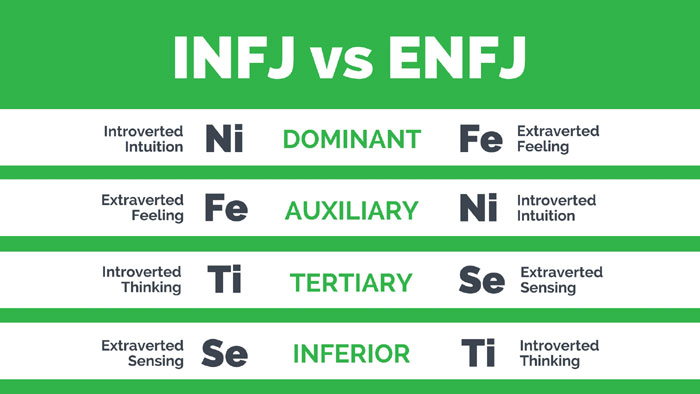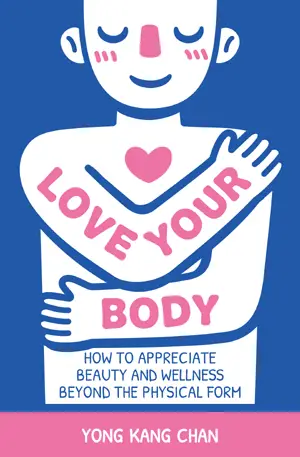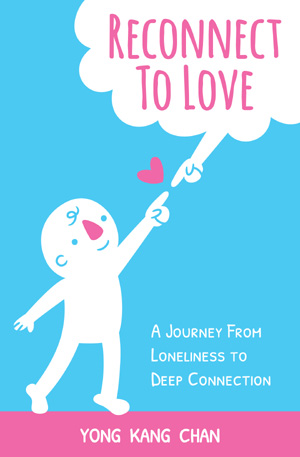Disclosure: There might be affiliate links on this page. As an Amazon Associate, I earn from qualifying purchases. This means I will earn a commission if you decide to make a purchase through my links but it will be at no additional cost to you.
INFJs and ENFJs click easily.
I am an INFJ and once I met an ENFJ for the first time in a group outing and we just started talking like we are old friends.
Even two INFJs might not have such a strong bond right at the start because we are slow to warm up to someone new. We will be like observing and assessing each other before we initiate a conversation.
In contrast, ENFJs are just warm and approachable right from the beginning.
INFJs and ENFJs are rather similar
when it comes to how we perceive information and make decisions.
However, there is still a clear difference in where we focus our energy and the order we perceive information and make decisions. Later, you will see the difference more clearly when I talk about the cognitive function stack of INFJs and ENFJs.
“Am I an INFJ?” Blog Post Series
This is the fourth part of the “Am I an INFJ?” blog post series. In this series, we will discuss the similarities and differences between INFJ and other personality types:
I’ll be using the cognitive function to explain the differences between the various personality types. Each MBTI type has its own unique function stack (i.e. the order of your cognitive preference). So a difference in one letter results in a different order.
If you want to learn more about the function stack, here’s the cognitive functions chart for each of the 16 personality types.
Please note I’m neither a certified MBTI practitioner nor I wish to be one. I write this post based on my insights and observation of the people around me. If you have difficulties finding your MBTI type after reading this post, you can read other articles or hire and talk to a certified MBTI practitioner.
ENFJ vs INFJ: What’s the Confusion?
People get confused with introversion and extroversion because we think we have to choose one and give up the other. So we come up with the term ambivert to tell others that we are both an introvert and an extrovert.
In reality, introversion and extroversion fall on a spectrum. All of us (introverts and extroverts) need both time alone and interactions with other people. If you look at the cognitive functions chart, you will notice each of the 16 personality types comprises both the introverted functions and extraverted functions. And these functions are stacked in alternate order.
Having both the introverted and extraverted functions
make us a more balanced individual.
However, when it comes to determining our MBTI type, we are talking about our preferences, not our needs. Our preferences have an order. It’s like going to a buffet, you can’t eat all the food you love at the same time. You choose your favorite food first and when you are full, you give up on food that you moderately like.
In addition, some people find it difficult to determine their types because they are afraid of putting on the introvert or extrovert label. Like the ENFJ I met in the outing, she told us that she’s an INFJ. But it’s very apparent from the group interaction, she’s not like the rest of us.
Our childhood experience can affect how we view ourselves. The ENFJ doesn’t feel comfortable with being an extrovert because she was told to keep quiet when she was young. Her family found her too noisy as a kid. Subconsciously, she has to suppress her natural preferences to please her family. She was later typed as an ENFJ by a certified MBTI practitioner.
So if you are confused with your types, be sure to check your childhood experiences and see if they have influenced your answers to the MBTI questionnaire.
INFJ or ENFJ?: A Quick Test
If you want a quick test and a fun way to determine if you are an INFJ or an ENFJ, answer the following question:
In a group setting, are you more likely to speak or listen?
It’s rather easy to tell the difference between INFJ and ENFJ in a group. ENFJs tend to both speak and listen in a group while INFJs are usually silent and very quiet in a group. We are so silent that you might not even notice that we are in the group.
It’s not just about how much a person speaks in the group. It’s also about the energy and vibe they give off. ENFJs have a way of drawing attention and people to them because they are just so warm and friendly. They focus a lot on other people and people like to be around them.
INFJs, on the other hand, tend to be withdrawn, private, and inner-focused. Yes, we can be warm and friendly too. But we are usually more subtle. Our warmth is more apparent in smaller groups or 1-1 conversation. The bigger the group is, the quieter we get. In a group setting, we are usually the listeners and we observe the group dynamics before we decide whether to speak up or not.
INFJs are also not in control of a group conversation most of the time. It’s not in our instinct to do so. We tend to just follow the flow of conversation. ENFJs have more leadership qualities and are more likely to facilitate or steer the group conversation in their direction with questions. I’ve seen ENFJs work their magic and their charm. It’s more natural for them.
INFJ and ENFJ Cognitive Function
INFJ’s cognitive functions stack is as follows:
- Introverted Intuition (Ni)
- Extraverted Feeling (Fe)
- Introverted Thinking (Ti)
- Extraverted Sensing (Se)
While an ENFJ cognitive functions stack is as follows:
- Extraverted Feeling (Fe)
- Introverted Intuition (Ni)
- Extraverted Sensing (Se)
- Introverted Thinking (Ti)
INFJs and ENFJs have the same first four functions.
But the order is slightly different.
These two personality types also have the same dominant and auxiliary functions but in reverse order. Our dominant and auxiliary functions define our personality the most. That’s why we are able to connect with each other so easily.
However, INFJs and ENFJs are still quite different because we lead with different dominant functions and our cognitive preferences are in a different order. So we tend to have different priorities in life.
4 Differences Between the INFJ and ENFJ Personality Types
1. INFJs and ENFJs have different priorities in life (Ni vs Fe).
INFJs live in a world of concepts and theory. We focus our attention internally on our vision and imagination. Our interactions with other people help us draw deeper insights into human behaviors and motivation.
ENFJs, on the other hand, focus their attention externally and on other people. They are highly attuned to other people’s needs and motivations. They also see the potential in other people and often encourage others to grow.
Also, due to their higher position of Fe and Se, ENFJs tend to be more pragmatic and care more about how accomplished they look in front of others than INFJs. INFJs tend to be more idealistic and usually don’t care whether others think they are successful or not. We care more about whether we reach our ideals or not.
INFJs are more intellectual and detached,
whereas ENFJs are more people-orientated.
Even though both INFJs and ENFJs have the same problem of putting people first, people-pleasing, and codependency, INFJs tend to be more individualistic as compared to an ENFJ.
We are also more likely to pick up on our unhealthy habits and change them before ENFJs do because we have a habit of recognizing patterns. We are able to see red flags earlier in the relationships too since we have introverted intuition (Ni) as our first function.
ENFJs are so people-focused that they might overlook their intuition sometimes when supporting others. They often become too selfless and neglect their own needs. It’s not always easy for them to not meet other people’s needs because keeping everyone happy is something they value and do very naturally.
In contrast, INFJs are naturally comfortable with solitude, being in our heads, and being away from people. We can stop our people-pleasing tendencies and codependency habits much easier by withdrawing ourselves and minimize contact with other people. Due to our private personality, we also don’t attract needy people (or people in general) as much as ENFJs do.
2. The amount that INFJs and ENFJs socialize is different (Fe in a different order).
Both INFJs and ENFJs are friendly and can talk to anyone easily. We care about other people’s feelings and we socialize quite similarly because we share the same extraverted function (Fe). However, the biggest difference is how much we socialize.
INFJs are more private, whereas ENFJs are more sociable.
Since INFJs have their extraverted feeling (Fe) as their second function, we use this function more like an afterthought. It’s secondary to our intuition. ENFJs show more interest in people and are less wary of strangers than we do. They will go up to someone new and just speak to them.
But for an INFJ, we are generally more cautious and selective at the start. We will usually observe and wait until we have more information about the other person or are more comfortable with the person. Therefore, we often appear to be reserved and disinterested, while ENFJs appear to be more friendly and sociable with others. So ENFJs end up having way more friends than INFJs do.
INFJs can stay at home and read books, watch TV, or think about life for a long period of time and yet feel energized. Even though we love connecting with others, we tend to get exhausted or burnout after a while of socializing and helping others. So we don’t do it that much.
Connecting with others sometimes brings us out of our flow too. Our intuition works better when we are not influenced by other people’s opinions. Thus, we need regular periods of downtime and alone time for recharge and reflection before our next interaction with people.
3. INFJs make decisions and take actions slower than ENFJs (Ni vs Fe).
Our judging functions (i.e. the feeling and thinking functions) help us to make decisions, while our perceiving functions (i.e. the intuition and sensing functions) help us to perceive information.
For ENFJs, their dominant function is a judging function (Fe), so they can quickly assess the mood of the environment and decide what action to take. For INFJs, their dominant function is a perceiving function (Ni). We would prefer to understand all the information that is available first, then make a decision. We take a longer time to reach the decision-making process than ENFJs.
INFJs are more passive, while ENFJs are more active.
ENFJs also have their extraverted sensing (Se) as their third function, which is higher than INFJs. They are usually more in tune with their surroundings and spend more time interacting with the physical world than INFJs. Thus, they are more comfortable with the outer world and taking action than introverts.
When I went on a holiday trip with my ENFJ friend, I’m very impressed by how fast my friend decided the direction to go. He’s like: Go left, go right. Then, go straight. Even if we make a wrong turn, he can quickly correct the course, so I trust him to lead the way.
If I were to lead, I would take up a map and slowly plan which way to go and take a lot of pauses along the way. Or even worse, I might be stuck in procrastination and analysis paralysis, figuring out what’s the best way to reach the destination.
Whenever there is an obstacle, INFJ’s natural tendency is to go inward first and plan, while ENFJ’s natural tendency is to go outward and interact with the world first, then adjust accordingly.
4. INFJs and ENFJs handle stress differently. (Ni-Ti loop and Se vs Fe-Se loop and Ti).
As mentioned previously, INFJ has a tendency to go inward first while ENFJ has a tendency to go outward first when they face an obstacle. This is especially apparent when we are facing stress.
When INFJs are under stress, we first focus internally and use our introverted functions (Ni and Ti) to help us resolve the problem. If we are unable to resolve the stress, we might end up in an overthinking loop called the Ni-Ti loop. We try to understand the problem and keep finding a solution within ourselves but we couldn’t find an answer.
When the NI-Ti loop breaks down, we engage our Se function and indulge in sensing activities that we don’t normally do to numb the pain. We might overeat, buy things that are meaningless to us, watch random TV shows, or be obsessed with data.
Under stress, we first utilize what we are familiar with.
But if it fails, we use our inferior function and do something uncharacteristic of us.
ENFJs are rather different when they are under stress. They focus externally and use their extraverted function (Fe and Se) to help them resolve their problem first. If they are unable to resolve the stress, they might end in an approval-seeking loop called the Fe-Se loop. They constantly seek validation from others and try to impress others with their image. They acquire material things to show their worthiness to others.
When the Fe-Se loop fails the ENFJs, they engage their Ti function and find themselves being critical and resenting others. Even though they generally keep these thoughts to themselves, they feel ashamed of having such critical thoughts toward others.
It’s also possible for ENFJs to engage in sensing activities like the INFJs and INFJs to be critical of others like an ENFJ under intense stress. But again, the order of operation is important. We usually use our inferior function only as a last resort to deal with our stress because we don’t identify as much with it.
Final Thoughts
Figuring out your MBTI type can be confusing sometimes. If you still feel lost about your MBTI type, watch the video below:
Featured Photo Credit: Elle Hughes









